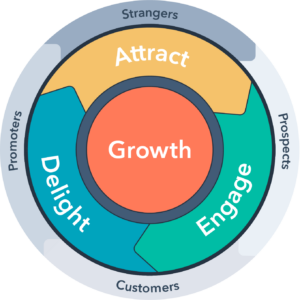You’ve probably heard the term inbound marketing before but may not be familiar with how it differs from traditional methods or why this way of doing things is on the rise…
Well you’re in the perfect place.
Here we will breakdown exactly what inbound marketing is and why you should start incorporating it into your marketing strategy.
The logic behind it
Inbound marketing is simply a way of gaining customers by creating valuable content and information for them which is helpful and free.
The theory is that when you provide helpful advice and content to your potential customers, you begin to build their trust. This means when they are ready to make a purchase, they already have a positive, trusting relationship with your business.
Helpful content can be anything from a blog post, e-book, video, infographics and more! All of this contributes to establishing your business as a trusted and valuable source of knowledge.
Ever since the term was first coined by Hubspot in 2006, inbound marketing has grown rapidly in popularity and is now an adopted approach by many big brands.

How does it work?
So, you create helpful information with the aim of solving your potential customer’s problems… but how does this generate you sales?
The idea is that when you provide valuable content you naturally attract the right people who you can engage with and delight over time. All of this happens within an individual’s buyer’s journey.
When customers have a successful experience and share this with others, it attracts new prospects to your business, creating a self-sustaining loop.
This is how your organisation builds momentum, and this is why the inbound methodology can be shown as a flywheel.
What is the flywheel?
The flywheel is a model adopted by Hubspot to illustrate the momentum your organisation can gain when it uses the inbound marketing method.

Happy customers fuel your growth when you solve their pain points and lead you to acquire further customers – this is considered a force for your flywheel.
On the other hand, things such as poor communication in handoffs between teams can lead to friction and slow your overall growth.
How can this apply to your business?
Friction can come in different forms and occur at any point in your customer’s buyers journey.
That’s why it’s important for your marketing, sales, and service teams to all understand the inbound marketing method and work to keep friction to a minimum.
For example, in the attract phase the marketing team will likely play the biggest role by doing things like blogging and running paid ads. But your sales team can also add force through social selling, and your service team can contribute by making it easier for current customers to make referrals.
And remember, just because you’ve closed on a sale doesn’t mean you should stop delighting your customer. After all, happy and delighted customers will stay with you for longer and keep the flywheel moving!
To sum it up
Inbound marketing isn’t necessarily a new thing, but it’s certainly a great way to fill up your sales funnel and attract people to your brand, as we hope we’ve shown here.
Keep your eyes peeled for future blogs where we will look at inbound marketing strategies in more depth!
If you’re interested in inbound marketing and would like to find out more, feel free to have a chat with one of us!


